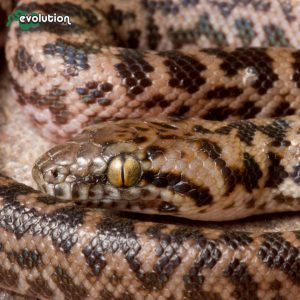Copyright 2021 Evolution Reptiles
All rights reserved.
Copyright 2025 Evolution Reptiles
All rights reserved.
All rights reserved.
One of the smaller python species, the spotted python is an Australian native although closely related species can be found on Papua New Guinea. Reaching a size of 100 to 140cm (39 to 55”), it’s small and docile enough to make an excellent pet. Both sexes attain the same size, although the largest wild individual ever recorded was a male.
In appearance, this is a light brown to tan snake with irregular blotches of a darker brown along its whole length. The spots are often ragged in appearance, because the darker pigmentation is only found on whole scales. The closely related Stimson’s python has a more reddish background colour, and the Children’s python has paler blotches that tend to fade as the animal ages.
Preferred habitat is highly variable, from open eucalypt woodland to dry savannah and scrub. They are often to be found on rocky hillsides, and will hunt around cave entrances and in rock crevices.

In the wild they are generalists when it comes to feeding, although one of their favourite prey items are bats that they find at the entrance to caves. They also take a lot of lizards, especially when young, but captive bred individuals don’t usually have a preference when it comes to feeding time. They can be greedy!
Feed your spotted python one defrosted mouse weekly, which should be no bigger than the largest part of the snake. Spotted pythons can eat mice their entire lives, although they do appreciate a little variety and can be offered gerbils, hamsters, rats and chicks as they mature. Resist the urge to feed your snake more often or larger prey as this can lead to the snake growing too fast, which can result in the head of the snake not growing at the same speed as the rest of the body. Obesity can also be a problem. If a snake is overfed they have no reason to move around their vivarium and this is detrimental to their health.
We have found, over the years, that it works perfectly well to place a hatchling into an adult sized enclosure, provided that there are sufficient hides to allow the baby snake to feel safe. (A good rule of thumb is that if the snake can move from one side of the enclosure to the other without showing itself, you have enough hides.) A 90cm (3’) vivarium can be used, but a 120cm (4’) is much better, as these are robust and active snakes that appreciate a good bit of space.
Spotted pythons require a temperature gradient of 25°C to 32°C during the day; this can be achieved by using a deep heat projector and a basking light on thermostats mounted at one side of the vivarium to create a warmer side. At night the temperature should drop to around 20°C to 25°C. A simple 12 hour light cycle is ideal for spotted pythons.UV lighting is recommended, although not considered essential.
The snake will require hides in the vivarium so that it can feel secure. By having several in different areas of the vivarium the snake will be able to choose the one that is at the best temperature. A humid hide is also recommended, hollow hides with a damp moss inside which snakes will often use when they are shedding their skin. Plastic plants are also good to use, as these look very attractive in the vivarium as well as offering privacy. Live plants can work as part of a bioactive setup, but most plants will be flattened or dug up by a curious snake.
Copyright 2021 Evolution Reptiles
All rights reserved.